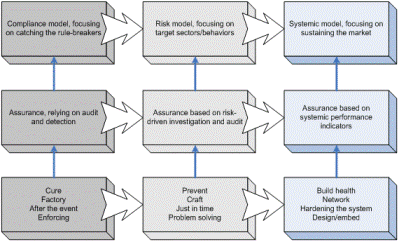Focusing on Risk

Regulation in fields such as health and policing has evolved thanks to risk management standardisation, so too should financial regulation.
Regulation in fields such as health and policing has evolved thanks to risk management standardisation, so too should financial regulation.
This diagram illustrates what I think is happening (or is it should be happening?) in the field of regulation; looking at and beyond the financial sector.

During the professionalism era of policing, law enforcement agencies concentrated on dealing with criminals and crime, rather than crime prevention. The Kansas City Preventive Patrol study in the 1970s found this approach to be ineffective, by means of empirical research. The experiment was carried out between 1972 and 1973 by the Police Department of Kansas City, Missouri, and was evaluated by the Police Foundation. It was designed to test the assumption that the presence (or potential presence) of police officers in marked cars reduces the likelihood of a crime being committed. It was the first study to demonstrate that research into the effectiveness of different policing styles could be carried out responsibly and safely. The study found that patrol officers in cars were disconnected from the community, and had insufficient contact and interaction with the community. This finding and associated further research and commentary by academics, opinion leaders and politicians caused a significant shift in policing strategies.
In the 1980s and 1990s, many law enforcement agencies in the USA and elsewhere began to adopt community policing strategies, while others adopted problem-oriented policing. A detour from the trend towards systemic approaches, known as zero tolerance or broken windows policing was introduced in the 1980s by James Wilson and George Kelling, who suggested that police should pay greater attention to minor quality of life offenses and disorderly conduct. This method was made popular in the early 1990s by then New York City Mayor and 2008 presidential candidate Rudy Giuliani. The assumption underlying zero tolerance strategies is that the visibility of broken windows, graffiti and other physical destruction or degradation of property, increases the likelihood of more criminal activities and destruction of property. To put it another way, if most of the windows in a building are already broken, what is the problem with breaking one more?
More recently, intelligence-led policing has emerged as the dominant philosophy guiding police strategy. Intelligence-led policing and problem-oriented policing are complementary strategies, both of which involve systematic use of information. The guiding philosophy of intelligence-led policing is to emphasise the collection and analysis of information to guide police operations, rather than the reverse. In the public policy domain, this is referred to as evidence based policy; in medicine it is known as evidence based medicine. In all these instances, using techniques from science, psychology, economics, engineering, and statistics, it is argued that professionals should make use of the best evidence to inform their activities.
This synchronicity should not be surprising, because, after all, company executives, regulators, police officers, doctors (and many others) are all dealing with the same kinds of problems and are trained in the same universities according to the same theories of knowledge. In modern times, universities are conformism engines, rather than hotbeds of radicalism and dissent. Therefore, it should not be surprising that the management of risk has replaced the detection and suppression of deviant behavior as a cross-disciplinary normative principle. To illustrate this point, when I plugged the words "crime and risk" into a search engine (Google) in April 2009, I was presented with 75.6 million items. The words "crime and detection" produced 374,000.
Each of the abovementioned professions is dealing with a complex system, where human beings are the greatest variable and where the objective is to maintain an optimum level of systemic health, accepting occasional breaches of rules, while seeking to prevent or at worse to deal quickly with systemic or endemic breaches of the rules. The engine that drives all these processes is risk. Risk is defined by Australian/New Zealand Risk Management Standard (AS/NZS 4360:2004) as "The chance of something happening that will have an impact on objectives". The statement is intentionally neutral, because the impact could be negative, the traditional view of risk, or positive, something we know as opportunities. Risk is inherent in everything humans do. The purpose of risk management is to manage those things that may harm our objectives and to identify and manage opportunities that may help us achieve our objectives. To understand how this works, let us turn to a subject dear to all of us, disease and the treatment of disease.
In the Middle Ages, disease was thought to be an affliction of the body caused by malignant influences that caused an "imbalance of humors", which, in turn caused an excess of blood, which is what gave rise to observed symptoms. If the problem was too much blood, the remedy was obvious, remove some of the blood from the patient's body. Bloodletting was a treatment for many diseases. When a large quantity of blood was required, the appropriate vein was cut. If only a small amount was to be removed, a leech would be used. If removing a small amount did not work, more blood was removed. We have no evidence on the efficacy of this form of therapy at the time, but modern science tells us that the chances of the patient being cured by removing blood would not be great, in most cases.
The underlying logic of the bloodletting approach is that the system is fundamentally healthy and that restoring health requires the restoration of the balance that keeps it healthy. That can be achieved by detecting the bad influence and removing it. This metaphor aligns with the view that society is inherently healthy, but prone to being unbalanced by individuals who embark on a life of crime. Remove the criminals, remove the crime, thus restoring the natural balance. This is the type of thinking that led Britain in the eighteenth and nineteenth centuries to remove its criminals from within its borders, first to the American colonies and then, after the American War of Independence, to what would eventually become Australia.
As the centuries pass, how we understand and treat disease has changed. Scientists, such as John Snow, gradually contributed to the development of the modern view of disease, which is predicated primarily on the transmission of disease by bacteria or viruses, which is called "germ theory". John Snow's story is well told in his own words in On the Mode of Communication of Cholera, first published in 1849, with the definitive edition published in 1854. The optimal treatment for diseases caused by viruses or bacteria is generally a drug or medicine or by vaccination. This metaphor aligns with the view that criminals are sick or otherwise disturbed individuals, who need to be identified and treated or corrected. This is the type of thinking that gave us prisons as correctional institutions, places where while incarcerated, prisoners would be offered training, education and rehabilitation, as a cure for their criminal tendencies.
The general view is that modern medicine, through drugs and vaccines, complemented by surgery, has made us healthier and given us longer lives than in previous centuries. Research tells us that this is not so, just as research tells us that incarcerating people does not give us lower rates of crime. The biggest contributor to a healthy society is the state of its environment, its water supply, its food supply, its air and its workplaces. All the drugs and all the wonderful surgical techniques we read about can make a significant difference to individuals, but they have relatively little impact on the health of a population. Improving diet, reducing the incidence of smoking or encouraging people to practice safe sex are far more significant lifesavers. That is why the modern approach to public health is concerned with determinants of health across a population, rather than what happens at the level of the individual.
Criminology has reached a similar conclusion, but the results it is producing do not match those achieved in public health. A case in point is the £400m cross-government commitment to reducing crime made by the British Government in 1999, "the biggest single investment in an evidence-based approach to crime reduction which has ever taken place in any country". This was the Crime Reduction Program (CRP), which had three goals: reducing crime, mainstreaming knowledge of best practice, and cost-effective crime reduction.
The CRP was made up of twenty linked crime reduction initiatives, delivered at the local level through "Crime and Disorder Reduction Partnerships". The CRP was not as much of a success as was hoped and, interestingly, the ensuing recommendations amounted to doing more of it, but doing it better – a bit like doing more bloodletting, but doing it better, perhaps?
You can see here, I think, that the trends we see in regulation are not isolated from other trends in areas of human activity that involve many of the same elements. This is useful, because it means that learnings in these related domains can be shared, albeit with appropriate caution. It also means that there would be merit if policy-makers in each of those domains were to share research, resources and intellectual horsepower, all of which are scarce and expensive commodities. Lastly, it means that those of you who want to be active players in the regulation game would do well to keep an eye on what goes on elsewhere, because events in related domains may act as lead indicators for what might happen in your world or give you ideas about what ought to happen, so that you can facilitate it happening, if you wish, or take steps to stop of modifying a trend you do not like.
What is it that is happening or about to happen? In brief, as with health, the focus of regulation is shifting on to the population, rather than on the errant individual or the aberrant business. The assumption is that hardening the economic system, making it less vulnerable to wrongdoing and more likely to lead to compliance, is the way to go. Embedding the rules into the fabric of the financial system and encouraging business enterprises to reflect internally the values the system has embraced are the twin tracks on which good governance is founded, at the macro and micro levels.
A concomitant development – I use that adverb because I do not know here which is cause and which is effect and it really does not matter – is the increasing drive towards standardisation. One might debate whether this demand is itself driven by a systemic requirement to control or limit the degree of variation in the system or whether the cause is something more prosaic, such as the efficiency that can be derived by constructing routines based around standards. Whatever the case may be, embedding the rules into everyday procedures through standardisation is, in my view, the future of regulation.
Patrick Callioni is a former senior public servant, with the Queensland and Australian Governments, and is now the Managing Director of consulting company, Enterprise Intelligence Pty Ltd, which specialises in helping business to do business with government and vice-versa. www.enterpriseintelligence.net.au His book Compliance Regulation and Financial Services is available at Amazon













